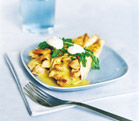
Mexican Food: History and Culture
Mexican food history is as rich and eclectic as its flavors. Following the Conquest of Mexico in 1521, Mexican food experienced a veritable culinary revolution. When the Spanish explorer, Cortez, and his conquistadors came to the Americas to seek riches, they found instead a cache of culinary delights such as chocolate, peanuts, vanilla, beans, squash, avocados, coconuts, maize and tomatoes. Alternatively, the Spanish introduced pork, beef, lamb, citrus fruits, garlic, cheese, milk, wheat, vinegar and wine into the new world. Prior to the arrival of Cortez, the Aztec emperor, Montezuma, was warned that some day bearded men mounted on animals resembling giant deer would usurp and plunder his kingdom. When the emperor got word that the men had landed on Vera Cruz, he tried in vain to keep them there with the promise of riches. Tempted and still hungry, Cortez stormed into Montezuma's capitol on November 8, 1519 with seven thousand recruited natives. Although he was received gracefully by Montezuma with a great feast, the diplomatic relations soon ceased, ushering in scores of bloody battles until August 13th, 1521 when Cortez seized the capitol. While the Spanish proceeded to systematically raze the Aztec empire and replace it with their own structures and institutions, the native culture and traditions remained until today in large part, namely the Mexican food culture. The nascent Mexican food tradition evolved through the influence of many different countries. Mexican food customs rely on recipes and ingredients from Africa, South America, the Caribbean, France and the orient that made there through the Spanish-Mexico influx.






